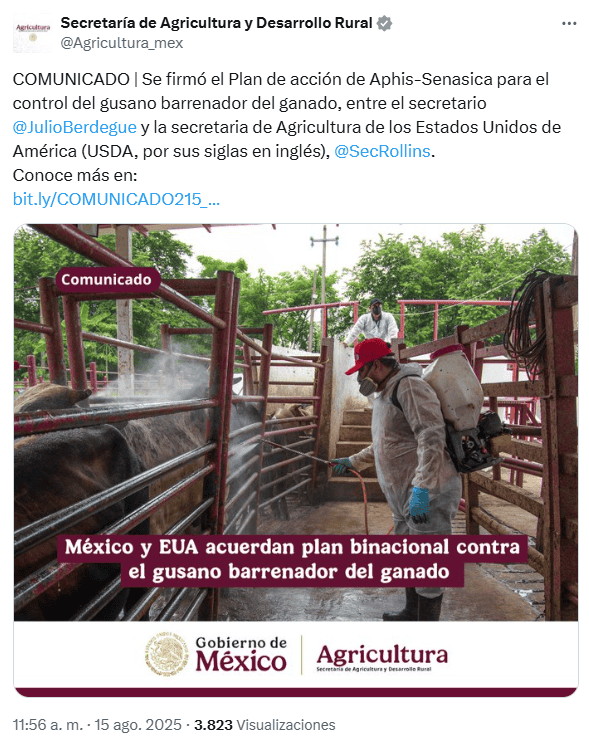Mexico and the US agree on a binational plan to combat screwworms.

Mexico and the United States agree on a binational plan to combat the screwworm plague . will allow the eventual resumption of livestock exports.
In a statement, the Ministry of Agriculture and Rural Development reported this Friday, August 15, that the Aphis-Senasica Action Plan for the control of the cattle screwworm was signed today by the federal secretary, Julio Berdegué Sacristán, and the Secretary of Agriculture of the United States of America (USDA), Brooke Rollins.
"Mexican experts from the National Service of Health, Safety, and Agri-Food Quality (Senasica) and U.S. experts from the Animal and Plant Health Inspection Service (APHIS) began developing the Action Plan during a workshop held on July 22, 23, and 24 in Mexico City," the text states.

The approved Plan, the document reports, includes a set of criteria and measures proposed by Mexico and now recognized by the US , including:
- The regionalization of the national territory
- A protocol for the safe importation of healthy livestock by sea
- The adoption of an innovative monitoring strategy based on fly attractant traps
- The criterion that the movement of cattle within the national territory may only be carried out from corrals certified by Senasica at origin to corrals equally certified at the cattle's destination
The Action Plan represents "an achievement that reflects the level of collaboration between both countries in the fight against the cattle screwworm (CWS)," the Ministry of Agriculture notes. "For the first time, there is a document that establishes objectives, goals, actions, budgets, and technical protocols" to address issues such as:
- Control of livestock movement
- Monitoring the spread of the pest
- Imports and movement of cattle from Central America to Mexico
- Surveillance of domestic animals and wildlife
- Guidelines for decisions on possible new suspensions in the future
It highlights that authorities from the Ministry of Environment and Natural Resources (Semarnat) of the Government of Mexico also participated in the development of the Plan, regarding the monitoring of cases that may occur in wildlife.
He points out that Mexico has long proposed the preparation of "an action plan of this type, with the goal of formalizing the commitments of both parties and, most importantly, providing certainty and predictability to ranchers, livestock exporters, domestic fattening companies, and the meat industry."
Finally, he says that "Both authorities celebrated the signing of the agreement formalizing the U.S. contributions to enable the new plant in Metapa de Domínguez, Chiapas, which will produce up to 100 million sterile flies per week to intensify the GBG control and eradication campaign."
It reports that Senasica began commissioning the plant on July 4, and it is expected to be fully operational in the first half of 2026.
*With information from the Ministry of Agriculture and Rural Development
*Stay up to date with the news, join our WhatsApp channel
Read also: Interpol issues red notice for Zhi Dong Zhang, the Chinese man linked to cartelsOF
informador




%3Aformat(png)%3Aquality(99)%3Awatermark(f.elconfidencial.com%2Ffile%2Fa73%2Ff85%2Fd17%2Fa73f85d17f0b2300eddff0d114d4ab10.png%2C0%2C275%2C1)%2Ff.elconfidencial.com%2Foriginal%2Faa8%2Ffba%2F085%2Faa8fba085b8db71c276e3671f88beda4.png&w=1280&q=100)
%3Aformat(jpg)%3Aquality(99)%3Awatermark(f.elconfidencial.com%2Ffile%2Fa73%2Ff85%2Fd17%2Fa73f85d17f0b2300eddff0d114d4ab10.png%2C0%2C275%2C1)%2Ff.elconfidencial.com%2Foriginal%2Fa9f%2Fd1c%2F3dc%2Fa9fd1c3dcf05253e8d3235f1d359859a.jpg&w=1280&q=100)